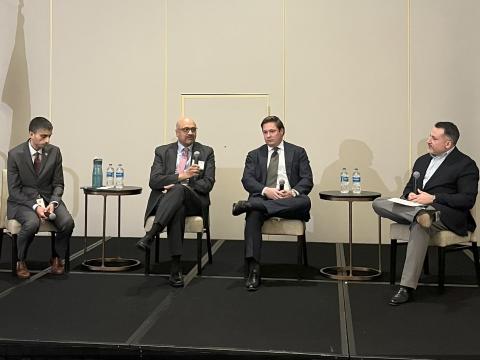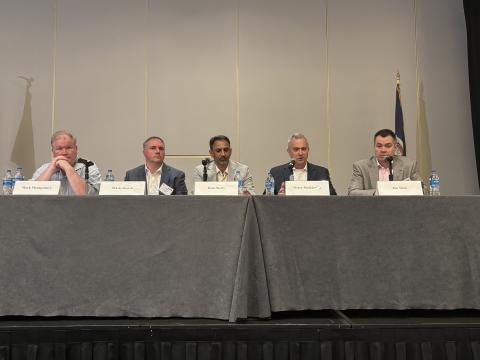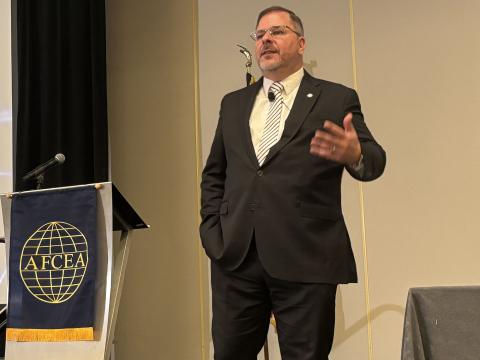Information Systems Agency Services the Services
 |
| Command operations and intelligence centers supporting current operations depend on the services and capabilities the Defense Information Systems Agency (DISA) provides to improve warfighting processes. |
Boosted bandwidth revolutionizes warfighting processes.
Focus with flexibility is now the hallmark of the U.S. Defense Department’s principal communications capabilities provider. Just 18 months after its third restructuring and in the midst of supporting current operations, the Defense Information Systems Agency is nearing final operational capability of a robust network foundation that will offer warfighters a mega-increase in bandwidth. At the same time, the agency has been meeting immediate needs with new services and scoping out a future that may include modularly designed Web services. These Web services would allow warfighters to harvest the information and intelligence they need from various sources in near-real time.
Not even six months into his position as chief technology officer (CTO) of the Defense Information Systems Agency (DISA), David M. Mihelcic already is effectively leading the charge for supplying defense agencies, combatant commanders and soldiers with the network support they need to fight the war on terrorism. Daily, he is receiving and responding to operational requests while at the same time ensuring that work on the program that will “eliminate bandwidth from the equation” is on track. With the help of DISA personnel, the services and industry, Mihelcic is facilitating a revolution in warfighting processes.
One of the essential projects in this effort is the Global Information Grid–Bandwidth Expansion (GIG-BE) program (SIGNAL, October 2003, page 65). The GIG-BE is particularly important to Mihelcic not only because he came to his current position from serving as the program’s deputy director and chief executive engineer but also because of the enormous effect it will have on warfighting. Scheduled to be fully operational by the end of September, the GIG-BE will increase bandwidth availability on the order of 1,000 to 2,000 times current levels, he maintains.
Mihelcic paints a picture of what this means to commanders. Most combatant commanders use the secret Internet protocol router network (SIPRNET) for warfighting processes such as exchanging classified messages through the Defense Message System, e-mail and real-time video and imagery. Today, the average connection speed is approximately 1 megabit per second, or less than half the speed of a user connecting to the Internet at home through a cable modem. “We’re going to take that 1 megabit per second and increase it up to 1 to 2 gigabits per second,” he affirms.
The benefits of this boost already have been demonstrated. Last September, the GIG-BE achieved initial operating capability (IOC). In October, the IOC configuration was set up at six sites participating in the Net-Centric Capabilities Pilot, also known as Oktoberfest (SIGNAL, October 2004, page 59). Although cryptography limited the IOC configuration to 100 megabits per second for classified network traffic, Mihelcic notes that participants could still move full-motion video from Predator unmanned aerial vehicles at a dozen streams in parallel without a glitch in the network. At the same time, DISA could distribute high-resolution images and enterprise services across thousands of miles in the continental United States and, from the operators’ view, the network performed just as well as when the server was in the next room. “So even at IOC, when we’ve only hit a 10th of what we expect to hit in the long term, we’re able to revolutionize some of the warfighting processes,” Mihelcic states.
The encryption restrictions are in the process of being addressed. The National Security Agency and several of its vendors are building the next-generation Internet-protocol-based high assurance Internet protocol encryptor (HAIPE), and a 1-gigabit-per-second HAIPE device was fully certified for classified traffic at the end of January. “We’ll begin installing those and retrofitting the previously installed 100-megabit-per-second equipment, increasing that fielded bandwidth—classified, secure bandwidth to the warfighter—by another order of magnitude,” he relates.
Implementation of the GIG-BE network at approximately 90 sites worldwide poses challenges daily, Mihelcic admits. “It’s a challenge because we are, in fact, installing a global network, and we’re doing it for the most part from scratch,” he says. Government and contractor personnel who are installing the network must assess and upgrade facilities to ensure adequate electricity and air conditioning. In some cases, the floors must be reinforced because carrier-class optical-switching equipment is being installed in government facilities for the first time.
For the communications infrastructure itself, when DISA has acquired fiber already installed underground by telecommunications companies, the agency must install amplifiers to “light” the dark cable. The equipment is being set up in huts that are approximately 60 miles apart.
Also, while DISA is installing the service delivery nodes at 90 bases, contractors are digging trenches to lay new fiber optic cable from the carrier backbones into posts, camps and stations. “Sometimes, this is straightforward; in other cases, they have to tear up miles of public land and have to agree with the local municipalities to acquire rights of way for the trenching,” Mihelcic explains.
“The challenges are daunting but not insurmountable. We are staying very close to schedule and cost. We’re also doing something that is really unparalleled in telecommunications in that we’re turning up the network all at once. Generally, the way a telecommunications company would do this would be to lay the fiber and test it, and then install another layer and so on. We’re installing and testing in parallel, trying to get warfighters on this network as soon as it’s certified,” he offers.
Although the GIG-BE is one of DISA’s largest projects at the moment, it certainly is not the only one. At the beginning of 2004, the agency’s Net-Centric Enterprise Services (NCES) initiative achieved milestone A, which means the concept had been refined, and senior leaders at the Pentagon were convinced that it should move forward to the technology development phase.
Some advanced technology development is underway now, Mihelcic says, and Oktoberfest was a successful NCES pilot in terms of demonstrating network-based services infrastructure and applications for connecting real-time and near-real-time communities of interest. Some of these were accredited from a security standpoint and were installed and working on the secret portion of the GIG-BE as well as the SIPRNET. U.S. Strategic Command (STRATCOM) and U.S. Joint Forces Command were able to exploit these services and improve their warfighting processes. For STRATCOM, first-generation enterprise services and network-centric applications allowed the command to accelerate its global strike planning business process, he says.
The CTO allows that current operations are a large part of DISA’s work today. Its role has changed with the launch of the Joint Task Force–Global Network Operations (JTF-GNO) Center, which directs the agency’s networks. “Fortunately, the commanders of both organizations are very close,” Mihelcic quips, “Gen. Raduege.” Lt. Gen. Harry D. Raduege Jr., USAF, director of DISA and commander, JTF-GNO, updates Mihelcic regularly and provides him with both clarity and focus for operating the networks.
DISA personnel have played a huge role in operation Iraqi Freedom from the very beginning, Mihelcic notes. “We had 100 people working for and with DISA in Baghdad, and they came in right after the tanks. They spent 18 months building all the communications. Now, we have turned it over to the Army as well as to the State Department, but the communications couldn’t have been accomplished without those DISA personnel who volunteered to go there,” he says.
The agency is constantly receiving requests for more capabilities from the troops in Iraq, and Mihelcic emphasizes that all the resources that are delivered have been tested and work on both the secret and unclassified Internet protocol routers. “We have delivered satellite bandwidth on the order of a hundredfold increase compared to pre-9/11,” he states.
DISA receives requests for capabilities it cannot deliver, Mihelcic reveals. For example, commanders wanted the ability to collaborate in the unclassified arena so they could work with industry and international partners. They were interested in using the Defense Collaboration Tool Suite (DCTS), which has been supporting classified collaboration on military networks for several years.
After assessing the possibility of modifying the DCTS to meet the requirement, DISA determined that it could not be delivered quickly. “Rather than giving up, we asked instead, ‘How else can we meet this challenge?’ We leveraged something that was already in place—the next-generation collaborative services pilot that the NCES program had started. Now, that capability is being used in support of tsunami relief operations to allow collaboration between the U.S. and other nations as well as nongovernmental organizations. We fully expect that the pilot capability will be exploited globally and will lead us to a full-production capability in the near future,” Mihelcic says.
The CTO admits that the relationship between DISA and the services is best characterized as love-hate. “The services love that DISA delivers services like satellite and bandwidth and commercial services on a moment’s notice. On the other hand, everybody hates it because we are viewed as a monopoly. We are not a monopoly. There are certain Defense Department policies that say that DISA should be the preferred service provider because it brings many equities,” he relates.
This problem is not one that DISA is ignoring. In fact, Mihelcic points out that in developing 500-day plans for the agency, Gen. Raduege solicits input from the combatant commanders, Defense Department agencies and services so he can set appropriate priorities. “It’s never perfect, because we are a service provider and sometimes the services would like to do the work themselves. So we listen to the customers so we can give them what they need instead of what we think they need,” he says.
Mihelcic believes DISA has a very good relationship with industry. He points out that the agency integrates commercial technologies and services and relies on the commercial sector to assist with solutions and integration.
The transformation to a lighter, more agile force depends on technology that supports network-centric warfare, and one of the key requirements is interoperable, standards-based solutions, he emphasizes. “Industry has to continue to make progress in those areas. We have to ensure that Cisco equipment can talk to Juniper equipment. That’s one of our real-world problems. Software is part of the upgrades that the services are using, so it has to be interoperable with NCES. Industry can help us by understanding that we need a service-oriented architecture instead of a system-oriented architecture,” Mihelcic states.
After attending a conference recently that featured information about future technologies, Mihelcic is excited about next-generation capabilities. He believes nanotechnology will be extremely important in the next 20 years. In addition, advances in robotics will enable the military to use robots in new and different ways than they are used today, he says.
“Exploitation of information technology will continue to burgeon. What we’re doing with the GIG-BE network as an IP-based network, which is the same direction our other communications programs are moving including the T-SAT [Tactical Satellite] and JTRS [Joint Tactical Radio System], is going to lead to basically an Internet that exists in multiple classification levels. We’ll see that capability become ubiquitous, so a warfighter in the field with a handheld radio could potentially get any information, anywhere on the GIG. It’s a very powerful concept.
“And the opening up of information using Web services to construct applications in a modular fashion is also powerful. Not only could you grab whatever data you need, but you could also compose new operational capabilities on the fly. For example, I’ve got a service over here that queries a database and listserv for names of known terrorists, and I’ve got a service over there that does pattern matching across all these documents. Now I can use that service to collect names and use this service to do pattern matching. Once I get a hit between those two, I can use a third service to geolocate the suspected location of that known terrorist. If you think about that, it’s almost Star Trek-like. We’re going to be able to build capabilities in near real time by just composing these modules of services that we built for solutions we knew we needed and now recompose them into solutions we didn’t know we needed,” Mihelcic predicts.
Web Resources
Defense Information Systems Agency: www.disa.mil
Global Information Grid–Bandwidth Expansion: www.disa.mil/main/prodsol/gig_be.html
Net-Centric Enterprise Services: www.disa.mil/main/prodsol/cs_nces.html




Comments